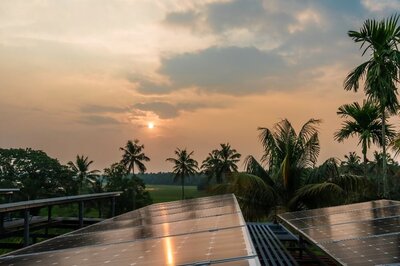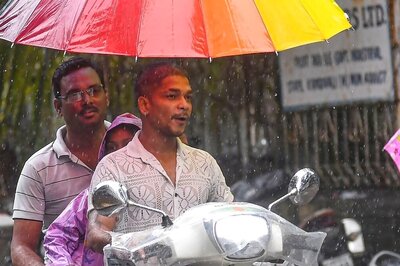
views
New Delhi: In the eyes of New Delhi, everyone is dispensable when it comes to projecting power," said Madhushree Mukherjee, a senior editor at Scientific American, adding that the government's decision to lift restriction on tourists visiting the isolated islands in the Andamans was "shockingly thoughtless" and although "India has always acted as a coloniser" of the islands, the current situation is "much worse than it was under the previous governments".
A former physicist, Mukherjee received a Guggenheim fellowship to research her book, ‘The Land of Naked People: Encounters with Stone Age Islanders’. The book narrates the devastating experiences of the hunter-gatherers of the Andaman Islands as they come face-to-face with civilisation.
The murder of 27-year-old John Allen Chau at the hands of protected and endangered Sentinelese tribe — the last remaining community that hasn't had contact with other humans for over 50,000 years — led to a huge controversy early this month, with activists and international non-profits pinning the blame on the Indian government.
The move to open up the North Sentinel Island in August, they argued, had paved the way for Chau landing up on the island. But Ministry of Home Affairs maintained that the issue had been one of "implementation" and not policy, claiming that the other protections still exist.
Mukherjee disagreed, saying: "The ministry has belatedly recognised that its order was ludicrous, and is backtracking. What do you implement, if not policy? It is not clear to me to what extent it was implemented on the ground."
Speaking about the risks of trying to retrieve Chau's body, she said there were only two ways to attempt such a thing: "Either go in with an armed force and risk fatalities" or "initiate a process of so-called friendly contact that will help them lose their fear of outsiders and eventually enable the body to be retrieved.
This, she warned, is inherently dangerous. "This is dangerous because of the risk of germs and other harms that will, with absolute certainty, follow. It would lead to the end of the Sentinelese as a viable culture and people."
Mukherjee’s fears aren't without precedent. Take, for instance the Great Andamanese tribe, who, as per Survival International, were actually made out of 10 district tribes but were clubbed together by the British. Their population plummeted after contact with the colonisers. Measles, influenza and syphilis came hand-in-hand with attempts to 'civilise them'. In 1970, the Indian administration moved them to Strait Island, where only 50 remain dependent on the government for their survival.
Asked about a larger impetus of viewing the island and its inhabitants as 'resources', Mukherjee drew a parallel between the Indian government and the British. "India has always acted as a coloniser on the islands. Like the British, it has treated them as a resource. The needs of the original inhabitants have been an afterthought. In that respect, the situation is much worse now than it was under previous governments," she said.
This exists, alongside an idea of viewing the hunter-gatherers as 'savages'. An idea, not restricted to the mainland but also the settlers on the islands. "People on the mainland and in fact many people on the Andamans who are from the mainland, think of the hunter-gatherers as “jungles” or “savages.” They think they can only bring benefits to them, as Chau did, and completely fail to understand them or to respect them and the choices they make. In recent years, a series of decisions are emanating from Delhi that will have a devastating impact on all the tribes of the Andaman and Nicobar islands. These include a railway line through the Jarawa reserve, a massive increase in tourist influx, etc.," Mukherjee pointed out.
The partial relaxation of norms is part of a larger Rs 10,000 crore project to wrestle the islands into modernity by encouraging tourism and boosting trade. Mukherjee called these "grand plans" a "gross conflict with environmental reality" and underlined that the Indian government had no idea about how fragile the islands are.
"These worlds can only collide with devastating effect to the Andaman tribes. Nor will the other people on the Andamans fare well. The Indian government has no idea how ecologically fragile the Andamans are. The only fresh water sources on South and Middle Andaman are from the Jarawa forest. If the Jarawa cease to protect their forest, and those are damaged, the fresh water will dry up and the lakhs of people on the islands will no longer be able to live there. Also, if there are 24 new ports as planned, container terminals and such like, the pollution of the water will be such that corals will die, accidents will lead to oil slicks, and the tourism will die," she said.
The plans to increase tourism has also brought on the spectre of 'tribal tourism', as pointed out by a number of activists. In 2013, the Supreme Court had banned tourists from taking the Andaman Trunk Road (ATR) after a video shot by a journalist showed policemen forcing six Jarawa women to dance for tourists.
Asked about whether the lifting of restriction could be seen as a larger impetus to promote 'tribal tourism', Mukherjee responded, "It is entirely possible. The lifting of restrictions was also for Strait Island. There is nothing to see there except for the Great Andamanese."
But she argued it was possible that development - a longstanding demand of the settlers in the island - could co-exist alongside protecting the fragile islands and its indigenous communities. "The claims of the settlers are valid too, and don’t necessarily conflict with those of the Andamanese. For instance, developing a shipping route that will serve as an alternative to the road through the Jarawa reserve, has been a long-standing demand of the Supreme Court."
But the new development plans contradicted each other. "All the shipping traffic that is envisaged will kill the tourism. There is nothing uglier than a container terminal, and the pollution of the sea will be tremendous. These contradictions are not fully through or deal with in the rush to develop the islands. A lot of the impetus for massive infrastructure is coming from military installations planned mostly for the Nicobars. The settlers don’t play a part in this," she said.
"In the eyes of New Delhi, everyone is dispensable when it comes to projecting power. When defense planners describe the islands as ‘unsinkable aircraft carriers’, you have to realise they are imagining them being bombed till there isn’t much left on the surface," she added.




















Comments
0 comment